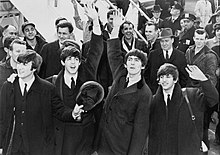The British Invasion
Beatles' releases in the United States were initially delayed for nearly a year when Capitol Records, EMI's American subsidiary, declined to issue either "Please Please Me" or "From Me to You". Negotiations with independent US labels led to the release of some singles, but issues with royalties and derision of The Beatles' "moptop" hairstyle posed further obstacles. Once Capitol did start to issue the material, rather than releasing the LPs in their original configuration, they compiled distinct US albums from an assortment of the band's recordings, and issued songs of their own choice as singles. American chart success came suddenly after a CBS news broadcast about British Beatlemania triggered great demand, leading Capitol to rush-release "I Want to Hold Your Hand" in December 1963. The band's US debut was already scheduled to take place a few weeks later.
 The Beatles arrive at John F. Kennedy International Airport, 7 February 1964
The Beatles arrive at John F. Kennedy International Airport, 7 February 1964 When The Beatles left the United Kingdom on 7 February 1964, an estimated four thousand fans gathered at Heathrow, waving and screaming as the aircraft took off. "I Want to Hold Your Hand" had sold 2.6 million copies in the US over the previous two weeks, but the group were still nervous about how they would be received.At New York's John F. Kennedy Airport[70]The Ed Sullivan Show, watched by approximately 74 million viewers—over 40 percent of the American population.The next morning one newspaper wrote that The Beatles "could not carry a tune across the Atlantic",but a day later their first US concert saw Beatlemania erupt at Washington Coliseum. Back in New York the following day, they met with another strong reception at Carnegie Hall. The band appeared on the weekly Ed Sullivan Show a second time, before returning to the UK on 22 February. During the week of 4 April, The Beatles held twelve positions on the Billboard Hot 100 singles chart, including the top five. That same week, a third American LP joined the two already in circulation; all three reached the first or second spot on the US album chart. The band's popularity generated unprecedented interest in British music, and a number of other UK acts subsequently made their own American debuts, successfully touring over the next three years in what was termed the British Invasion.The Beatles' hairstyle, unusually long for the era and still mocked by many adults, was widely adopted and became an emblem of the burgeoning youth culture. they were greeted by another vociferous crowd, estimated at about three thousand people. They gave their first live US television performance two days later on
The Beatles toured internationally in June. Staging thirty-two concerts over nineteen days in Denmark, the Netherlands, Hong Kong, Australia and New Zealand, they were ardently received at every venue. Starr was in hospital after a tonsillectomy for the first half of the tour, and Jimmie Nicol sat in on drums. In August they returned to the US, with a thirty-concert tour of twenty-three cities. Generating intense interest once again, the month-long tour attracted between ten and twenty thousand fans to each thirty-minute performance in cities from San Francisco to New York. However, their music could hardly be heard. On-stage amplification at the time was modest compared to modern-day equipment, and the band's small Vox amplifiers struggled to compete with the volume of sound generated by screaming fans. Forced to accept that neither they nor their audiences could hear the details of their performance, the band grew increasingly bored with the routine of concert touring. At the end of the August tour they were introduced to Bob Dylan in New York at the instigation of journalist Al Aronowitz. Visiting the band in their hotel suite, Dylan introduced them to cannabis.Music historian Jonathan Gould points out the musical and cultural significance of this meeting, before which the musicians' respective fanbases were "perceived as inhabiting two separate subcultural worlds": Dylan's core audience of "college kids with artistic or intellectual leanings, a dawning political and social idealism, and a mildly bohemian style" contrasted with The Beatles' core audience of "veritable 'teenyboppers'—kids in high school or grade school whose lives were totally wrapped up in the commercialized popular culture of television, radio, pop records, fan magazines, and teen fashion. They were seen as idolaters, not idealists." Within six months of the meeting, "Lennon would be making records on which he openly imitated Dylan's nasal drone, brittle strum, and introspective vocal persona." Within a year, Dylan would "proceed, with the help of a five-piece group and a Fender Stratocaster electric guitar, to shake the monkey of folk authenticity permanently off his back"; "the distinction between the folk and rock audiences would have nearly evaporated"; and The Beatles' audience would be "showing signs of growing up".

No comments:
Post a Comment